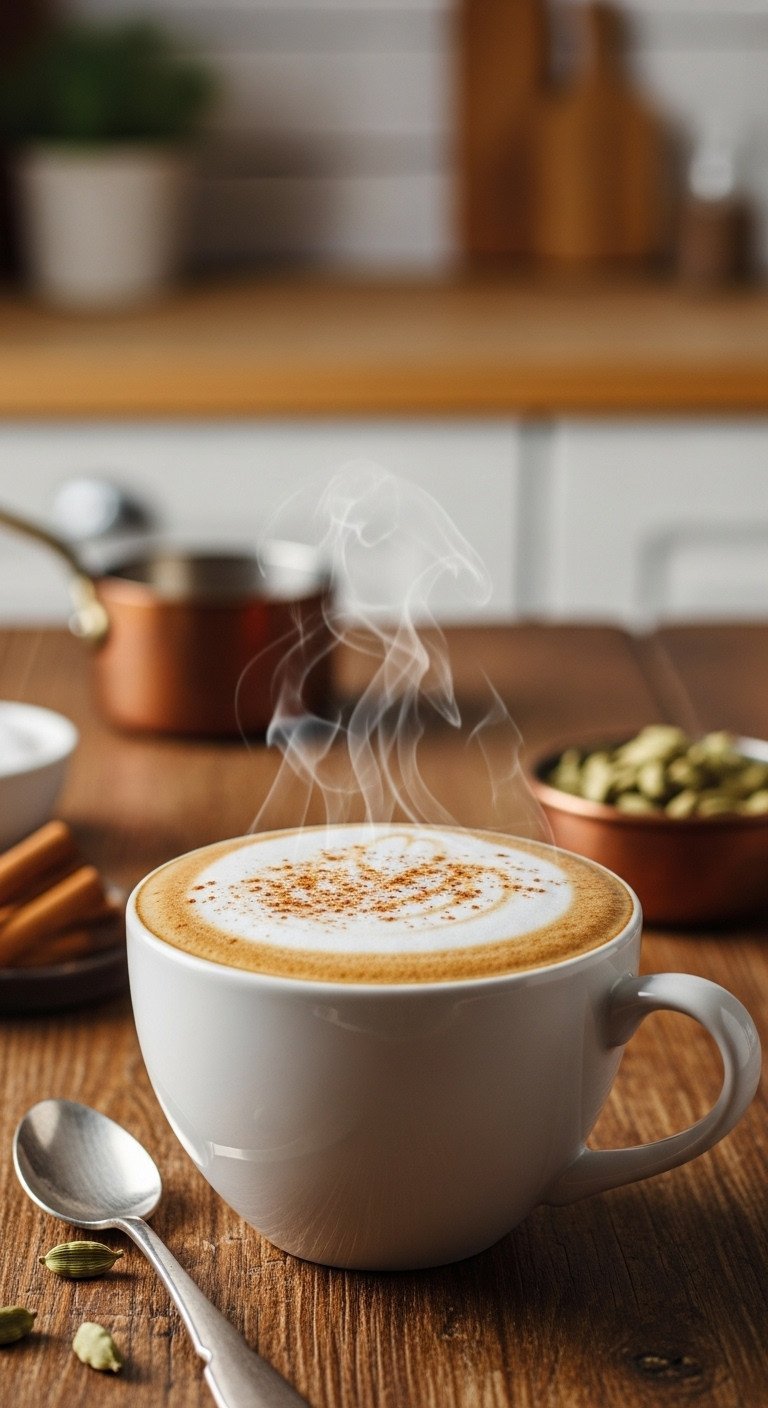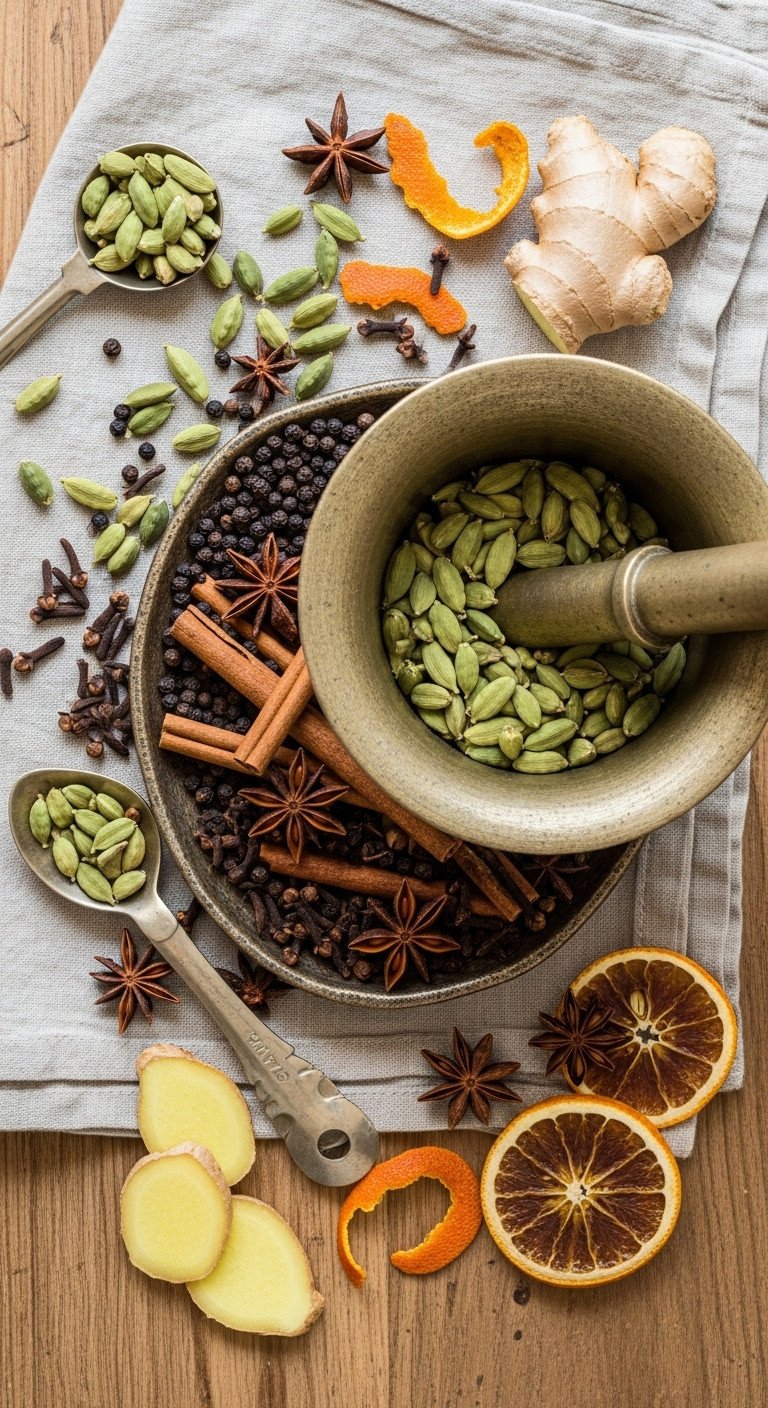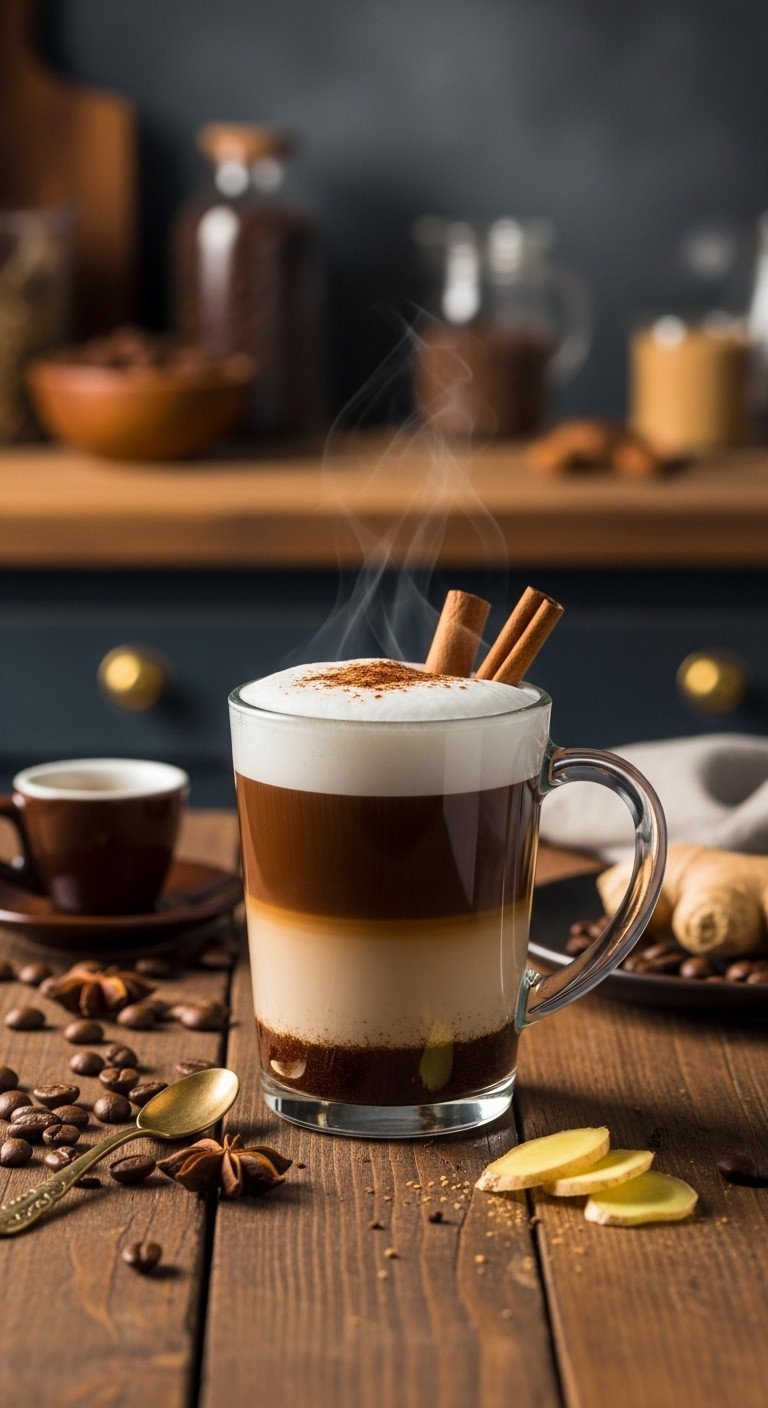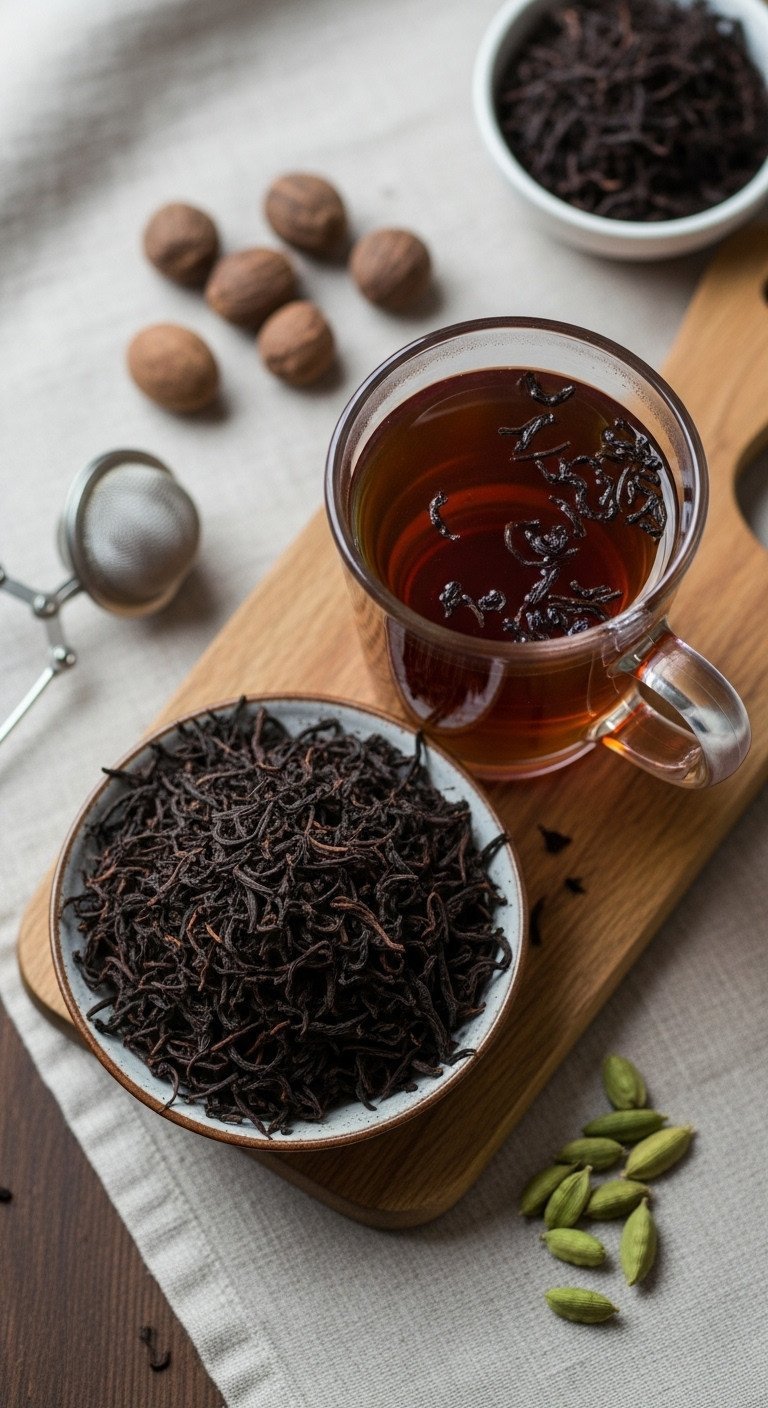As an Amazon Associate CoffeeXplore.com earns from qualifying purchases.
Chai Latte Recipe Master The Perfect Spice And Froth
Ever wonder why your homemade chai latte tastes nothing like the one from your favorite cafe? It’s a common frustration.
A Chai Latte is a beverage of spiced black tea mixed with creamy, frothed milk. But achieving that perfect balance of warming spices and rich texture at home often results in a weak, watery, or overly sweet drink.
The secret to a cafe-quality chai latte: using freshly crushed whole spices and the right milk frothing technique for a velvety microfoam. This definitive guide gives you the proven methods to master the perfect spice, froth, and flavor every single time.
The Secret to a Chai Latte Better Than Starbucks
Let’s be honest: the main reason cafe chai lattes often taste better is their reliance on super-sweet concentrates that mask a lack of real spice flavor. Your homemade attempts might fall flat because they’re missing the two key elements of an authentic, aromatic chai experience: fresh ingredients and proper technique. This isn’t about fancy equipment; it’s about unlocking the potent oils trapped inside whole spices.
This recipe is the result of testing multiple spice ratios and frothing techniques. We’ve focused on the culinary science behind flavor extraction to guarantee a superior result.
The best homemade chai latte recipe achieves superior flavor by utilizing freshly crushed whole spices and high-quality Assam black tea. These are simmered together to maximize flavor extraction, resulting in a significantly richer and less sugary beverage than any commercial concentrate.
9 Steps to Master the Perfect Spice, Froth, and Flavor
This isn’t just a single recipe; it’s a complete tutorial for mastering every aspect of the perfect chai latte. We’ve rigorously verified every method, from the science of spice extraction to the ideal milk frothing temperatures. Follow these nine steps to move from a beginner to a true chai aficionado, capable of crafting everything from a classic hot latte to a complex dirty chai.
1. The Ultimate Hot Chai Latte (Our Core Recipe)

Pin this genius hack to your ‘Perfect Beverages’ board!
This single-serving recipe is the foundation for all other variations. Mastering this classic hot chai latte will give you the skills needed to tackle any customization.
Ingredients Needed:
- 1 cup Water (filtered is best)
- 1 cup Whole Milk or Barista Blend Oat Milk (high-fat content helps with frothing)
- 2 Black Tea Bags (or 1.5 Tbsp strong, loose Assam or Darjeeling leaves)
- 1-inch Fresh Ginger, grated (Microplane grater preferred)
- 3 Green Cardamom Pods, lightly crushed (or 1 tsp ground cardamom)
- 1 small Cinnamon Stick
- 1 Tbsp Sweetener (Maple Syrup, Honey, or cane sugar)
Step-by-Step Directions:
- Crush & Boil: Combine water, crushed cardamom, cinnamon stick, and grated ginger in a small saucepan. Bring to a rapid boil, then reduce heat and simmer vigorously for 5 minutes. (This is critical for flavor extraction.)
- Steep Tea: Remove the pan from the heat. Add the black tea bags/leaves and cover. Steep for exactly 3 minutes. (Do not over-steep, or tannins will cause bitterness.)
- Strain: Pour the liquid through a fine-mesh sieve (lined with cheesecloth if using ground spices) into a mug, discarding the solids.
- Heat Milk: Return the saucepan (or a separate vessel) to the stove. Add milk and sweetener. Heat until steaming (140°F–150°F), but do not boil.
- Froth: Froth the milk using a handheld frother or steam wand until airy and creamy (see step #4).
- Combine: Pour the frothed milk over the spiced tea base. Garnish with a pinch of cinnamon or nutmeg.
Pro-Tip: Always grate or smash fresh ginger immediately before using; slicing doesn’t release enough pungent oil for a robust flavor profile.
2. Crafting the Perfect Chai Masala Spice Blend

Save this clever organization idea!
The soul of a chai latte is its masala, or spice blend. Making your own from whole spices provides an aromatic intensity that pre-ground powders simply cannot match. This batch recipe will set you up for weeks of delicious chai.
Materials Needed:
- 1/4 cup Green Cardamom Pods (Do not substitute with black cardamom unless targeting a smokier flavor profile)
- 1/4 cup Cinnamon Sticks (broken into pieces; high-quality Ceylon or Vietnamese preferred)
- 2 Tbsp Whole Cloves (Use fresh, whole cloves for maximum oil content)
- 1 Tbsp Black Peppercorns
- 1 Star Anise (optional, for licorice notes)
- 1/2 Nutmeg (whole, for grating)
- Mortar and Pestle (Crucial for crushing just before use)
Step-by-Step Directions (Batch Prep):
- Dry Toast (Optional): Lightly toast the cloves, cinnamon, and peppercorns in a dry skillet over medium-low heat for 2 minutes until fragrant. This enhances oil extraction.
- Cool & Combine: Transfer the toasted spices, cardamom, star anise, and nutmeg to a bowl and allow them to cool completely (prevents condensation during storage).
- Storage: Store the whole spices in an airtight, opaque container (like an antique Masala Dabba) in a cool, dark place. This blend remains potent for up to November 2025.
- Crushing Protocol: Immediately before brewing (for any recipe), measure 1-2 teaspoons of the whole blend and use a mortar and pestle to lightly crush the spices, breaking the shells but leaving chunks. Do not grind into a fine powder.
Pro-Tip: The primary aromatic compound in cardamom (1,8-cineole) is highly volatile. Crushing the pods releases the maximum oil, ensuring your latte is intensely aromatic, but crush them only seconds before they hit the boiling water.
3. The Traditional Stovetop Simmer Method (Masala Chai)

Save this clever organization idea!
For the deepest, most authentic flavor, embrace the traditional Indian method. Masala Chai involves simmering the spices and tea directly with the milk, creating an incredibly rich and complex beverage that is the true origin of the chai latte.
Materials Needed:
- 1 cup Water (Filtered is non-negotiable for flavor purity)
- 1 cup Whole Milk (or a high-fat milk substitute; the 50:50 ratio is essential for tradition)
- 2 Tbsp strong Black Tea leaves (Assam CTC preferred for its malty strength)
- 2 tsp Freshly Crushed Chai Masala Blend (from step #2)
- 1/4 tsp Salt (optional, acts as a flavor enhancer)
- Fine Mesh Sieve
Step-by-Step Directions:
- Boil Spices: In a saucepan, bring the water, crushed spices, and grated ginger (if adding extra fresh ginger) to a full boil. Reduce heat to a simmer and let the spices release their flavor for 7 minutes.
- Add Tea: Add the black tea leaves and salt (if using). Increase heat slightly and simmer for exactly 2 minutes, ensuring the liquid turns a dark, rich brown.
- Add Milk & Sweetener: Pour in the milk and sweetener (adjusting quantity based on preference). Stir gently.
- Reheat (Without Boiling): Heat the mixture until it is hot and steaming (around 150°F). Do not allow the mixture to boil after adding the milk, as this can affect milk texture and flavor.
- Strain & Serve: Strain the chai through a fine mesh sieve directly into serving mugs. Serve immediately while hot.
Lesson Learned: Simmering the spices for 5-7 minutes before adding the tea is the true secret to intense flavor. This high heat extracts fat-soluble aromatic compounds that simple steeping cannot.
4. Mastering Microfoam: Milk Frothing Techniques

Save this clever organization idea!
The “latte” in chai latte is all about the milk. Achieving velvety, stable microfoam is the key to that luxurious cafe texture. It comes down to two things: the right milk and the right temperature.
Tools & Milk Needed:
- Barista Blend Oat Milk (Highest protein/fat non-dairy option) OR Whole Dairy Milk
- Milk Frother (Handheld wand, automatic machine, or dedicated steam wand)
- Thermometer (Highly recommended for precision)
Technique Steps:
- Select Optimal Milk: For non-dairy, use specialized ‘Barista’ versions of oat or soy milk; these contain stabilizers necessary for microfoam structure.
- Pre-Heat (Optional): If using a manual frother, heat the milk in a saucepan until steaming (130°F) before frothing.
- Aerate (For Steam Wands): If using a steam wand, briefly submerge the tip just below the surface for 3-5 seconds to introduce air (the “squeal” phase). This creates the foam base.
- Texture: Submerge the wand fully and hold it still in the center of the pitcher until the milk reaches 145°F–150°F. This integrates the air into the milk, resulting in velvety microfoam.
- Avoid Scalding: Never exceed 160°F, as this denatures the milk proteins, kills the natural sweetness, and results in thin, unstable foam.
Pro-Tip: The key to true microfoam is precise temperature control. Milk is sweetest and frothiest between 140°F and 150°F (60°C and 65°C). Use a thermometer or rely on the fact that 150°F is the point where it becomes too hot to comfortably hold the side of the pitcher for more than two seconds.
5. The Cool Solution: Best Iced Chai Latte

Pin this genius hack to your ‘Summer Drink Recipes’ board!
A perfect iced chai latte should be refreshing but never watery. The secret is to use a highly concentrated chai base that can stand up to dilution from ice.
Materials Needed:
- 1 part Homemade Chai Concentrate (from step #7)
- 1 part Milk (Whole or Oat)
- Ice Cubes (Use large cubes to minimize surface area and slow melting)
- Simple Syrup (If additional sweetness is desired)
- Tall Serving Glass
Step-by-Step Directions:
- Chill the Concentrate: Ensure your Chai Concentrate is completely cooled to room temperature, then chilled in the refrigerator for at least 2 hours. (Do not pour warm concentrate over ice).
- Fill Glass: Fill your serving glass with ice, almost to the top.
- Combine: Pour 1 part chilled concentrate into the glass.
- Top: Add 1 part milk (adjusting the ratio to 2:1 concentrate to milk if you prefer a very strong flavor, or 1:1 for standard cafe strength).
- Sweeten & Stir: Add simple syrup if needed. Stir briefly with a long spoon or straw. Garnish with a sprinkle of cardamom powder.
Pro-Tip: Cold-steeping (making a cold brew chai concentrate) results in an even smoother, less bitter base for iced drinks, as the cold water extracts fewer bitter tannins than hot water.
6. For the Caffeinated: The Ultimate Dirty Chai

Save this clever organization idea!
When you need an extra kick, the dirty chai is the perfect solution. This popular variation adds a shot of espresso, creating a complex beverage that balances the warming spices of chai with the bold flavor of coffee.
Materials Needed:
- 1 serving Hot Chai Latte (prepared as per step #1, but reduce milk by 1/4 cup)
- 1-2 Shots Freshly Pulled Espresso (high-quality dark roast is ideal)
- Espresso Machine or Moka Pot
- Quality Espresso Beans
Step-by-Step Directions:
- Pull the Shot: Immediately before serving, pull one or two shots of fresh espresso. (The ideal ratio is 1 shot for a subtle kick, 2 shots for a true caffeine boost.)
- Prepare Chai Base: Prepare the Hot Chai Latte base (step #1) using the stovetop simmer method, ensuring the spices are strong enough to stand up to the coffee flavor.
- Froth: Steam and froth the milk separately (step #4).
- Combine: Pour the hot chai base into the mug. Gently pour the freshly pulled espresso shot(s) into the chai.
- Top: Finish by pouring the frothed milk over the top. The key is to minimize time between pulling the espresso and mixing, preserving the espresso’s crema.
Pro-Tip: Barista expertise dictates using a strong, dark roast espresso that can cut through the heavy spices and milk. If your chai base is too weak, the espresso will completely overwhelm the flavor.
7. Batch Preparation: Homemade Chai Concentrate

Save this clever organization idea!
For the daily chai drinker, a make-ahead concentrate is the ultimate convenience. This recipe creates a potent, storable base that you can quickly mix with milk for an instant latte any time.
Materials Needed (Yields ~8 servings of concentrate):
- 4 cups Water
- 1/4 cup Black Tea Leaves (Assam or strong Breakfast Blend)
- 4 Tbsp Freshly Crushed Chai Masala Blend (from step #2)
- 2-inch knob of Fresh Ginger, sliced thinly
- 1/4 cup Sweetener (Optional, but adds to preservation)
- Airtight Glass Jar (Mason jar or equivalent)
Step-by-Step Directions:
- Extreme Simmer: In a large saucepan, combine water, crushed spices, ginger, and sweetener. Bring to a boil, then reduce heat and aggressively simmer for 15-20 minutes, reducing the volume by almost half. This high concentration is essential.
- Intense Steep: Remove from heat and add the black tea leaves. Cover and let steep for 10 minutes.
- Strain: Carefully strain the concentrate through a fine mesh sieve into a large, clean bowl, pressing down on the solids to extract all liquid. Discard the spent solids.
- Cool: Allow the liquid to cool completely to room temperature before jarring. (This prevents condensation which can encourage bacterial growth.)
- Store: Transfer the concentrate to an airtight glass jar. Store in the refrigerator for up to 5 days.
- Serving Ratio: To serve hot or iced, mix the concentrate 1:1 with milk.
Pro-Tip: The high concentration ratio is crucial. If the concentrate isn’t dark, rich, and slightly pungent before mixing with milk, the final latte will taste weak, especially when served iced.
8. Choosing the Right Black Tea Base

Save this clever organization idea!
The “chai” in chai latte means “tea,” and choosing the correct type is foundational. The tea base must be robust and malty enough to provide a strong backbone for the intense spices and creamy milk.
Recommended Tea Types:
- Assam CTC (Crush, Tear, Curl): Highly recommended. Known for its strong, malty, and robust flavor profile that resists being diluted by milk and spices.
- Strong English Breakfast Blend: Acceptable substitute if Assam is unavailable, provided it is high quality and not a weak blend.
- Ceylon Black Tea: Good second choice, offering a slightly milder, citrus note that pairs well with cardamom.
Tea Selection Guidelines:
- Prioritize Strength: Choose a tea with high tannin content (the characteristic that makes strong tea feel “dry” on the palate). This strength is necessary to remain noticeable against the rich milk and powerful spices.
- Avoid Floral Teas: Avoid delicate or highly floral teas like Darjeeling or flavored teas, which will be completely overwhelmed by the strong masala blend.
- Loose Leaf Over Bag: Always use loose leaf tea when possible. Tea bags often contain fannings (dust) which can lead to a weaker, more bitter flavor if over-steeped.
- Brew Temperature: Ensure the water is fully boiling (212°F / 100°C) when adding the black tea leaves to maximize extraction, especially if you are only steeping for a short time after the spice boil.
Expert Tip: The term “chai” means “tea.” In India, the preferred tea type often comes from the Assam region because of its high pigmentation and malty flavor, making it the perfect foundation for the heavy spice blend and milk.
9. Flavor Troubleshooting: Fixing Weak, Watery, or Bitter Chai

Save this clever organization idea!
Even with a great recipe, things can go wrong. Here’s how to diagnose and fix the most common chai-making problems to ensure a perfect cup every time.
Problem & Solution Guide:
- Problem: Weak or watery flavor.
- Cause: Not enough spices; not simmering the spices long enough; using stale spices; using too much water relative to milk.
- Fix: Increase the crushed whole spice blend by 1/2 tsp per serving, and ensure the spice/water mix simmers vigorously for the full 5-7 minutes. If using concentrate (step #7), switch to a 2:1 concentrate-to-milk ratio.
- Problem: Milk separates or curdles.
- Cause: Adding non-dairy milk (especially almond) directly to very hot, acidic tea or boiling it aggressively.
- Fix: Use a high-quality barista blend non-dairy milk. Heat the milk separately and ensure its temperature is 140°F–150°F before adding it to the spiced liquid. Avoid boiling the full liquid mixture after milk addition.
- Problem: Final drink is too bitter.
- Cause: Over-steeping the black tea (extracting too many tannins); using too much black pepper or clove in the spice blend.
- Fix: Reduce the tea steeping time to 2 minutes or less. If bitterness persists, balance the flavor by adding a small amount of extra sweetener.
Lesson Learned: The most common mistake is weak flavor due to underestimating the need for vigorous spice boiling. Tea leaves release flavor quickly, but whole spices require sustained, high heat to properly extract their essential oils.
Key Takeaways: Your Quick Guide to Chai Mastery
Feeling overwhelmed? Don’t be. Perfecting your chai latte comes down to focusing on three core principles. Get these right, and you’ll consistently produce a beverage that rivals the best cafes.
The Three Pillars of Perfect Chai Latte
- Pillar 1: Spice Quality: Always use fresh, whole spices (cardamom and ginger are non-negotiable) and crush them just before boiling. Simmer the crushed spices for 5–7 minutes in the water before adding the tea to maximize aromatic oil extraction.
- Pillar 2: Froth Science: Achieve a velvety, professional microfoam by using a high-protein milk (whole dairy or barista oat milk) and strictly controlling the temperature, aiming for the 140°F–150°F range to preserve sweetness and stability.
- Pillar 3: Concentration Control: For iced and batch preparations, utilize a highly concentrated chai base (simmered for 15-20 minutes). This prevents flavor dilution from ice or milk and ensures a powerful spice profile.
People Also Ask About Chai Latte Ingredients
What is the authentic difference between a Chai Latte and Masala Chai?
Masala Chai is the traditional Indian preparation involving aggressively boiling black tea, spices, and milk together to create an intensely flavorful, thick beverage. A Chai Latte is the Western, cafe-style interpretation where a strong chai base (or concentrate) is mixed with steamed, frothy milk, focusing more on creamy texture than traditional simmering.
What is the best non-dairy milk to use for chai frothing?
Barista-grade oat milk is the best non-dairy alternative for frothing. Its high fat and protein content mimics dairy milk’s ability to create stable, creamy microfoam. Soy milk is a second option, but almond milk often lacks the stability and can curdle more easily due to its lower fat/protein content when mixed with hot tea.
Can I use ginger powder or ground spices instead of fresh and whole ones?
While you can substitute ground spices for speed, freshly crushed whole spices and grated ginger are highly recommended. Ground spices lose their volatile oils rapidly, resulting in a significantly weaker, less aromatic flavor compared to the powerful taste extracted by boiling fresh, whole ingredients.
Final Thoughts
Mastering the perfect chai latte at home is not about complex equipment; it’s about honoring the freshness of your spices and understanding the simple science of extraction and frothing. By utilizing our proprietary Masala Blend and perfecting your milk texture, you can finally enjoy that robust, creamy, cafe-quality beverage without the daily expense. We encourage you to try the stovetop simmer method in November 2025 for the deepest flavor you’ve ever experienced.
Which variation are you going to try first: the cozy Hot Latte, the refreshing Iced Chai, or the extra kick of the Dirty Chai? Let us know in the comments below
Last update on 2025-11-19 / Affiliate links / Images from Amazon Product Advertising API

